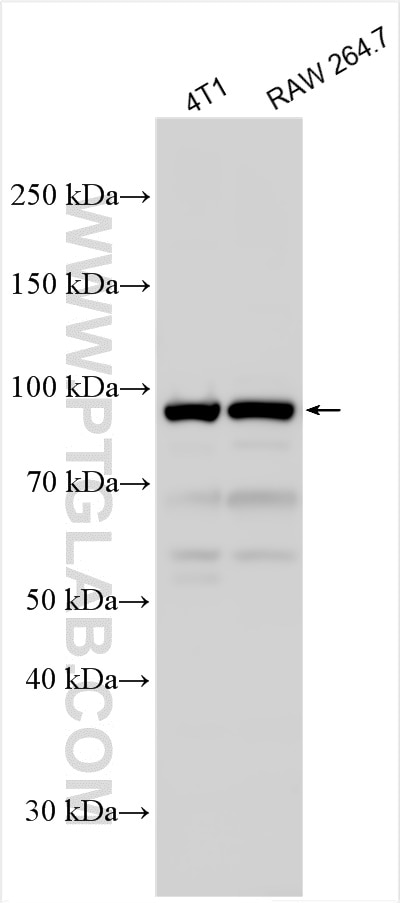Tested Applications
| Positive WB detected in | 4T1 cells, RAW 264.7 cells |
Recommended dilution
| Application | Dilution |
|---|---|
| Western Blot (WB) | WB : 1:1000-1:6000 |
| It is recommended that this reagent should be titrated in each testing system to obtain optimal results. | |
| Sample-dependent, Check data in validation data gallery. | |
Product Information
14770-1-AP targets NOD1 in WB, ELISA applications and shows reactivity with human, mouse samples.
| Tested Reactivity | human, mouse |
| Host / Isotype | Rabbit / IgG |
| Class | Polyclonal |
| Type | Antibody |
| Immunogen |
CatNo: Ag6567 Product name: Recombinant human NOD1 protein Source: e coli.-derived, PET28a Tag: 6*His Domain: 195-532 aa of BC040339 Sequence: GETIFILGDAGVGKSMLLQRLQSLWATGRLDAGVKFFFHFRCRMFSCFKESDRLCLQDLLFKHYCYPERDPEEVFAFLLRFPHVALFTFDGLDELHSDLDLSRVPDSSCPWEPAHPLVLLANLLSGKLLKGASKLLTARTGIEVPRQFLRKKVLLRGFSPSHLRAYARRMFPERALQDRLLSQLEANPNLCSLCSVPLFCWIIFRCFQHFRAAFEGSPQLPDCTMTLTDVFLLVTEVHLNRMQPSSLVQRNTHSPVETLHAGRDTLCSLGQVAHRGMEKSLFVFTQEEVQASGLQERDMQLGFLRALPELGPGGDQQSYEFFHLTLQAFFTAFFLVLD Predict reactive species |
| Full Name | nucleotide-binding oligomerization domain containing 1 |
| Calculated Molecular Weight | 108 kDa |
| Observed Molecular Weight | 90-100 kDa |
| GenBank Accession Number | BC040339 |
| Gene Symbol | NOD1 |
| Gene ID (NCBI) | 10392 |
| Conjugate | Unconjugated |
| Form | Liquid |
| Purification Method | Antigen affinity purification |
| UNIPROT ID | Q9Y239 |
| Storage Buffer | PBS with 0.02% sodium azide and 50% glycerol, pH 7.3. |
| Storage Conditions | Store at -20°C. Stable for one year after shipment. Aliquoting is unnecessary for -20oC storage. 20ul sizes contain 0.1% BSA. |
Background Information
NOD1 protein contains a caspase recruitment domain (CARD). NOD1 is a member of NOD-like receptor protein family and is a close relative of NOD2. NOD1 is ubiquitously expressed and recognizes bacterial peptidoglycan fragments, including d-glutamyl-meso-diaminopimelic acid found in gram-negative and some gram-positive bacteria. NOD1 plays a role in innate immunity by acting as a pattern-recognition receptor (PRR) that binds bacterial peptidoglycans and initiates inflammation. This protein has also been implicated in the immune response to viral and parasitic infection.
Protocols
| Product Specific Protocols | |
|---|---|
| WB protocol for NOD1 antibody 14770-1-AP | Download protocol |
| Standard Protocols | |
|---|---|
| Click here to view our Standard Protocols |




